2021
April
29
|
Be an ontophile!
Yesterday I attributed to Melody an unusual intellectual virtue. I said:
Jeff Duntemann asked me to coin a word to describe this kind of person —
somebody who wants to know, "What is this and why is it interesting?" about
everything they encounter.
Note that I do not mean someone who masters a lot of pursuits. You can know
the point of something without mastering it. Conversely, you can spend a lot of time
tediously learning something without ever seeing the interesting main point — high-school algebra
students frequently do that.
The concept is hard enough to express in English, and I am not aware of any existing
philosophical terms to describe it. But I do have a word to offer:
Ontophile.
Onto- is Greek for "existing." By ontophile I mean someone who wants to
know what
exists, or wants to know about everything that exists.
That is not too precise. Using more precise Greek words from Aristotle,
ousiophile or hylophile might be more accurate,
meaning someone who wants the essence or the substance of everything, but ontophile
is easier to spell, and it dovetails nicely into the expanding usage and importance
of the word ontology.
Ontology is the area of philosophy that studies what kinds of things exist.
Is there an alternate universe? Are souls different from bodies? Those are
ontological questions.
In computer science, an ontology is, nowadays, a repertoire of kinds of things that
can be described and modelled. On a trivial level, a software system for a school
might have an ontology that includes students, courses, and graduation requirements, but
not (say) weather. Artificial intelligence systems often have large ontologies.
An ontophile is a person who wants to have a big and thorough ontology.
That can include things you don't think actually exist (unicorns, pagan deities);
you want to know what the people who do believe in them have in mind.
Being an ontophile does not obligate you to take an interest in useless, foolish, or
harmful things. It means you want to know the point of things that are, by
some reliable criterion, worth knowing about. It means you don't want large areas
of human knowledge to go right past you without having any idea what you'd find if
you delved into them.
So I christen the word ontophile, like a newly built ship, and launch it
into the world. Enjoy!
Permanent link to this entry


|
2021
April
28
|
45 years ago today: The art museum
[Revised and extended.]
Today Melody and I were going to re-enact part of our first date,
a visit to the
Georgia Museum of Art,
but the museum is closed on Wednesdays due to pandemic cutbacks,
so we'll go Saturday, which, confusingly, is the anniversary
of our second date. But I did give her flowers today.
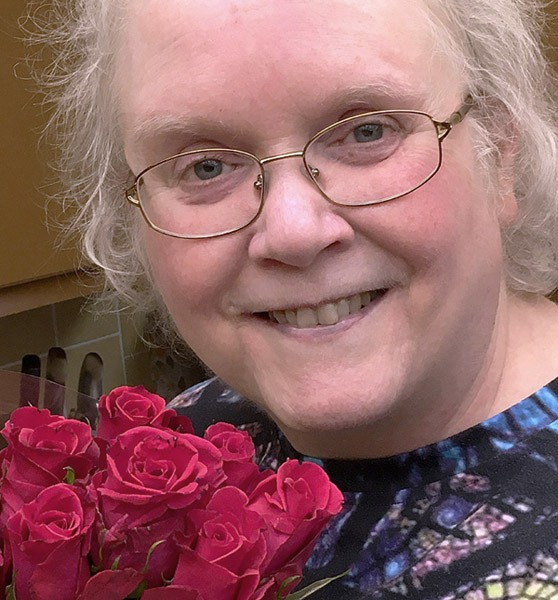
And, this evening, we went out to dinner for the first time since the lockdown.
It is permitted, though we have to wear masks when we're not at our table eating.
We went to Chicken Salad Chick, which bears no resemblance to any place we ate
in our younger days, but suits us now, and we walked through the Michael's art-supply
store (one of Melody's few strolls through a store since the lockdown).
Life is gradually returning to normal.
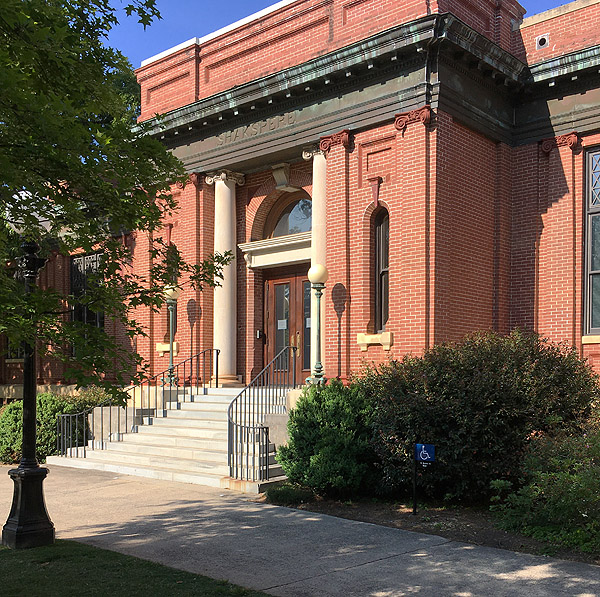
Building that formerly housed the Georgia Museum of Art
On today's date back in 1976, Melody was a 17-year-old high school senior
jointly enrolled in high school
and Gainesville Junior College, and an art course assigned her to come and see the museum.
There was no special exhibit on at the time, just the permanent collection.
I was an 18-year-old college junior (yes, I was ahead of my time).
We had been writing letters to each other since we met the previous November
at a recruiting event
(click on that link for the story).
I was expecting to welcome her into my circle of friends when
she transferred to UGA in the fall.
She told me about this upcoming trip to our campus, and we arranged
to meet at the museum. It was a Wednesday, just like today.
Of course, the museum wasn't in its new building then. It was in this building,
which is now the administration building and had once been the library
(inscribed SHAKSPERE as part of a series of authors' names, some of them
oddly spelled). At the time, the windows, not compatible with art galleries,
were covered up by panels decorated on the outside with
rather dark Cubist-style patterns, making the building look even stranger.
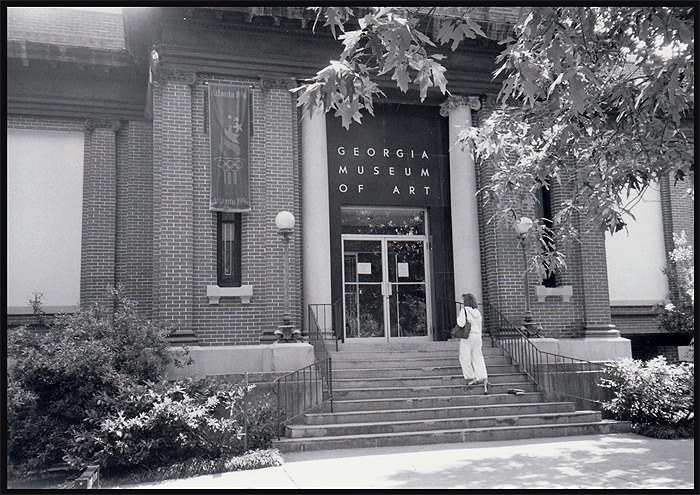
The museum a mere 20 years after our visit (1996). At that time the window
coverings were light-colored. Photo courtesy of the Georgia Museum of Art.
[UPDATE! I found, among my own color slides, a picture of the museum taken close to
the time of Melody's and my visit, showing what I called Cubist-style window covers, although I'm not
sure I'll stick with that description. This may be a rare image capturing
a phase of history that no one else photographed. Here it is:]

We remember some of the pictures we saw that day (and have seen several times since),
including
"La Confidence"
("The Secret"), by Elizabeth Jane Gardner Bouguereau,
and
a portrait by S. F. B. Morse
(the inventor of the telegraph, who was also a portrait painter).
Here's part of what I wrote in my journal:
Obviously, this was a visit that could have been short, but we ended up making
it as long as we could. (I had to rush off just after 4 p.m. to get ready for an
Honors Program banquet in the evening.) By the end of the visit, Melody was well on the way
to being my best friend. Whether it would be more than friendship, I was not sure,
but later in the same journal entry I at least broached the possibility.
The musical moment in the chapel encapsulated the whole day: I was surprised by a piece
of beautiful music and had someone to share it with who enjoyed it the same way.
In trying to guess what piece of music it might have been, I learned that Mozart
composed many clarinet duets. What we heard might have been the first
movement, or any movement, of K. 487.

The University Chapel in 2021, being set up for a wedding, which is its main use now that the School of Music
has moved to East Campus. Normally there are no flowers on the stage, of course.
The late 19th-century painting depicts St. Peter's Basilica and is described as the largest framed oil painting in the world.
We knew already from each other's letters that we would have a lot to talk about,
but on that day I really began to appreciate Melody's intellectual breadth.
She was an art major who had been a GHP alternate in mathematics
and had grown up working in a hardware store.
Like me, she had the habit of picking up random books in libraries just
to see what was in them, and also of reading encyclopedias.
She wanted to know at least a little about everything she encountered —
to have pegs to hang things on, so to speak.
All my life, I had had a lot of specialized interests, many of them leading to real
achievements, which I pursued alone.
Some people shared some of my interests but about other interests could only say,
"That's impressive,
but I could never understand it." Melody never said that.
She had a unique ability to see the point of everything I was
interested in, whether science, art, music, literature, or gadgetry. Everything!
I don't mean she was master of all trades, only that she had an active mind and
saw why I was interested in things. And she wasn't pretending.
Melody became the first friend I had ever had
with whom I did not have to set aside,
as an interest not shared, anything
that I really cared about.
Already, on April 28, 1976,
Melody was the
most enjoyable company I had ever been in.
If the only time we had ever
had together had been that single two-hour visit, I would still have remembered
it and been enriched by it for the rest of my life.
A bit of background:
The "Baptist Center" ("BSU") described here is a student center run by the Georgia Baptist Convention,
about which I have written elsewhere.
It was where we spent most of our free time the following year, when we were both
at the University.
The University at the time had no pay-by-the-hour parking, and it was virtually impossible to visit the
art museum from off campus!
I must have requested permission for Melody to park her car at the BSU, though I don't remember it.
Either that, or she parked there on her own and took her chances. The BSU issued parking permits to active
members, but my dim recollection is that they were only enforced during the most crowded time of day,
10 a.m. to noon.
In any case, my journal entry says the BSU is where her car was at the end
of the day.
Brad McColl was the (former) cartoonist for the student
newspaper and was very good. The exhibit must have been retrospective because
his LinkedIn page says he graduated in 1974
(with exactly the same art degree that Melody got in 1979).
We never knew him personally, but we enjoyed his work.
We think we remember one of the cartoons in the Memorial Hall exhibit
(it is certainly a Brad McColl cartoon that we saw somewhere, and we both have dim
recollections of seeing it in the gallery).
At the time, students were often frustrated by course listings that
had "Staff" in place of the instructor's name. So Brad drew a group of students in a classroom
looking at a lectern behind which stands not a professor, but a shepherd's staff.
April 28 is a significant date for another reason too.
On Sunday, April 28, 1968, I publicly professed faith in Christ and joined First Baptist Church
of Valdosta, Georgia. But it was a slow start; it might be fair to say that I was not
much of a practicing Christian until about 1971.
Permanent link to this entry


|
2021
April
23
|
Xi Ursae Majoris (Alula Australis) missing?
The past few nights, I've gotten my telescope out for visual observing on the
newly-repaired iOptron GEM45 mount, even under mediocre conditions, in order to
give the mount plenty of exercise. One thing I've done is look at some double
stars with rapid orbital motion. I made diagrams of several of them for my
2002 book Celestial Objects for
Modern Telescopes, and now quite a few of them look appreciably different
than when I observed them then. Here is one:

Copyright 2002, 2021 Michael A. Covington
This star is also known as ξ (xi) Ursae Majoris and as Alula Australis.
The iOptron mount contains the full Hipparcos catalog, so I tried finding this
star by its Hipparcos number, HIP 55203...
and all I got was "No data." I came inside and looked up the number in several
places. Definitely 55203.
Apparently iOptron has an omission in its database. I had no trouble finding the
same star in the list of named stars (Alula Australis) and viewed it after getting
to it that way. [Note: There is a revision to the iOptron firmware
that I do not yet have. Maybe the omission has been remedied.]
Permanent link to this entry
Short notes
Music of the month:
Richard Hillert's Festival Canticle
("This is the feast of victory for our God"). If you're a Lutheran, you've heard it a
zillion times. As a Baptist turned Presbyterian, I hadn't heard it since I worshipped
with a group of Lutherans at Yale around 1981. When I found it again, it sent the same
chill down my spine. All the more so because I had never heard a good performance of it,
just a small group singing informally.
Hillert's music was composed in the 1970s, but much of it sounds
centuries old. This is in fact the most modern-sounding of the pieces
I've heard, and it doesn't sound very modern. Hillert is continuing
a tradition and doing so very well.
COVID update: Uncertain. Georgia's numbers haven't kept going down. At least
we're not seeing explosive growth.
But we are glad that the death rate has gone down markedly, and also that we ourselves
are "fully vaccinated" (not totally immune, but maybe 20 times better off that we would
be without vaccines).
Permanent link to this entry


|
2021
April
21
|
I think it was an Easter blip
Georgia's COVID case reports are again declining slowly, week-over-week, and have been
for three to five days depending on exactly how you count them.
Each day's figures have to be compared to those from a week earlier because of
a strong weekly cycle in the way reporting is done. Moving averages are also useful.
We had a rapid fall, followed by a near flattening out, followed by a disconcerting slow
rise around April 6 to 16. That has turned into a slow decline again.
Now that we have some statistics about the onset of cases, not just the date they were
reported, the situation is becoming clearer. It looks as if there was a spike in new
cases whose onset was April 12 or a few days earlier. That's just right for people to
have gotten COVID on Easter (April 4) or at family gatherings leading up to it.
I can't fault people for going to church on Easter, especially after a year of exile,
and I'm glad we got only a slight bump, not explosive growth.
If I am reading the statistics right, we will now see a more definitive decline,
though still not a rapid one.
[Update:]
There were two Easter blips, around April 12 and 19, and it took until the end of the
month for the second one to completely pass. As of April 28, we are confident that the
infection rate is going down, even if we don't see it in the daily case rate.
Today Melody, now "fully vaccinated," is taking advantage of the fact that she
is allowed to visit her mother in Winder.
Permanent link to this entry


|
2021
April
18
|
An afternoon at the library
Today I spent a couple of hours at my old haunt, the UGA Science Library.
Apart from about three very brief visits, this is my first time there since
the first week of March, 2020.
I'm fully vaccinated and just four days short of reaching maximum immunity,
so my chance of catching COVID is low, and I was able to find a cloth mask that
doesn't fog up my glasses, so I went and actually read books and magazines.
I wanted to see what's going on in Make (answer: all hobby electronics
now involves Arduinos or the like), and I also browsed through some of
Malcolm Longair's writings about the history of physics, which I want to
come back to.
After spending so many decades doing so much of my work in libraries, I enjoy what
I call "the hum of the hive" and what Cathy calls "the privacy of the crowd."
That is, I concentrate best when there are people around, talking softly to each other,
not disturbing me. That is better than being alone, partly because it's more
familiar, and partly because I don't have to
be on the lookout for interruptions.
I don't expect to return to working at the library the way I did most of my life.
FormFree will have plenty of office space for me in their new building, which opens
May 1 (we think). But I still hope to get back to the University every few days.
I don't want to pull up my roots there entirely.
Permanent link to this entry


|
2021
April
14
|
A mall going downhill
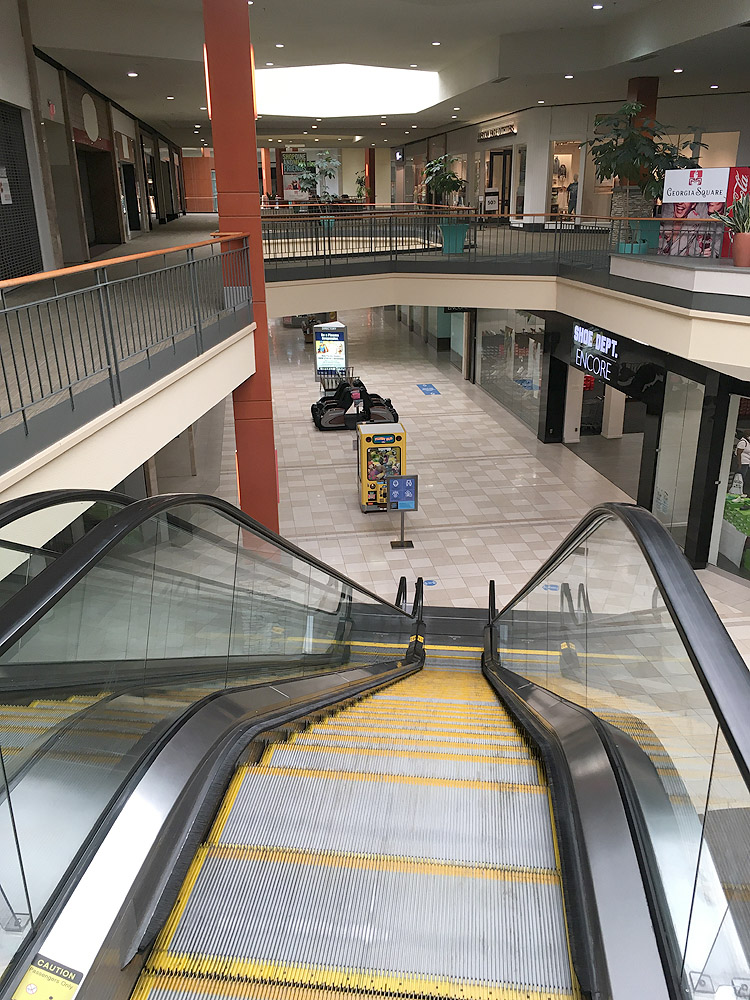
Today was the first time I had gone mall-walking since before the March 11, 2020, lockdown.
I actually set foot in the mall two Saturdays ago, but only to take some clothes to be altered;
it was surprisingly crowded considering the lack of stores. Today it was almost empty,
and I figured I couldn't catch COVID from people who aren't there. Anyhow, I'm 6 days past
the second vaccination, and my susceptibility is perhaps 10% of what it used to be.
The only remaining anchor store is Belk's, and it had its upstairs mall entrance closed off
(possibly creating a fire safety problem — no upstairs exit). About half of the
storefronts are vacant. Small stores on the ground floor seem to attract most of the traffic.
Permanent link to this entry
COVID going up
Georgia's COVID case numbers have been going up gradually for a few days.
(They dropped after the March 20 rise, but they've started rising again.)
Of course, that tells us what the disease was doing about a fortnight ago,
and we don't know whether it settled back down or grew exponentially after that.
Time will tell. Vaccination should push it down soon.
The three of us received the second Pfizer vaccination on April 8, and I had 5 or
almost 6 days of side effects (flu-like), probably worsened by working too hard on
days 1 and 2 when I should have been resting. Sharon had a slightly easier time,
and Melody, an easier time yet.
I can no longer post publicly on Facebook because of hecklers. People are angry at COVID
and want to take it out on anybody who brings any information about it, even just relaying
articles from very reliable sources. It is, shall we say, bad form to step into a conversation
among scientists (in various fields, but all scientists) and say that statistics should not
be used to make decisions. (What do you use, then?)
I do not think this person would have done any such thing face-to-face.
Permanent link to this entry


|
2021
April
5
|
Back in the (iOptron GEM45) saddle
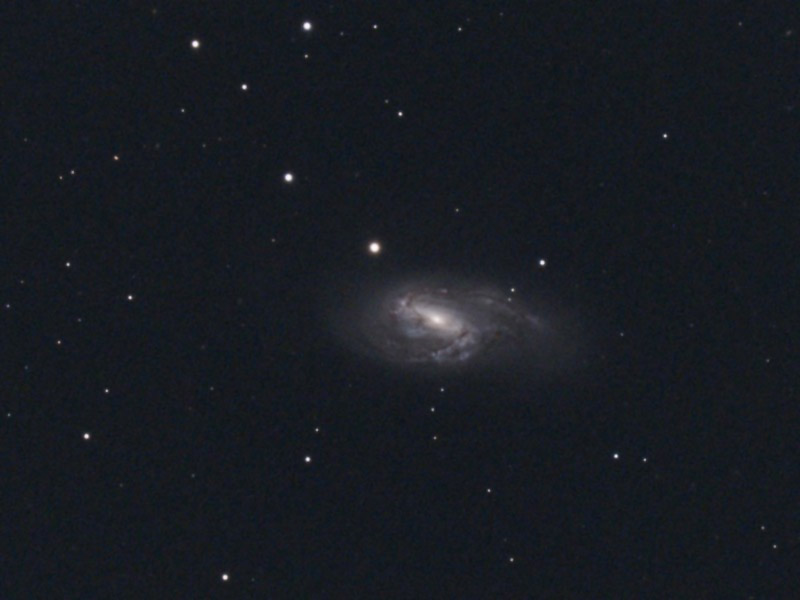
Here's the galaxy M66. I took this picture rather hastily this evening to
test my iOptron GEM45 equatorial mount, which has just come back from repair.
Stack of eight 2-minute exposures, Nikon D5500 H-alpha modified, ISO 200,
Celestron 8 EdgeHD with f/7 reducer.
The GEM45 had been suffering a rather rare but spectacular electronic failure
that made it oscillate about 5 arc-seconds back and forth at a rate of 1.5 times
per second. This was due to a failure of the circuitry that microsteps the stepper motors,
so that although the motor was still rotating at the correct rate, the rotation
was uneven. I've heard of one or two other iOptron owners with the same problem,
and my understanding is that iOptron has now made a change to the circuit design.
This same mount had been in the shop with excessive periodic gear error, or
so I thought, but in fact I wonder if it was the same problem, or related to it.
A fast oscillation, sampled at a rate that is almost but not quite commensurable
with its frequency, can look like a slow oscillation.

Here is a badly composed photograph of my setup. I took this quick snapshot
to keep a record of how to place the counterweights, and also because my iPhone marks
each picture with the latitude and longitude, handy for documenting an observing
site, though not necessary in my driveway.
Permanent link to this entry


|
2021
April
4
|
Feast day of the Resurrection of Our Lord
Make no mistake: if He rose at all
it was as His body;
if the cells’ dissolution did not reverse, the molecules reknit,
the amino acids rekindle,
the Church will fall.
It was not as the flowers,
each soft Spring recurrent;
it was not as His Spirit in the mouths and fuddled
eyes of the eleven apostles;
it was as His flesh: ours.
The same hinged thumbs and toes
the same valved heart
that — pierced — died, withered, paused, and then
regathered out of enduring Might
new strength to enclose.
Let us not mock God with metaphor,
analogy, sidestepping, transcendence;
making of the event a parable, a sign painted in the
faded credulity of earlier ages:
let us walk through the door.
The stone is rolled back, not papier-mâché,
not a stone in a story,
but the vast rock of materiality that in the slow
grinding of time will eclipse for each of us
the wide light of day.
And if we will have an angel at the tomb,
make it a real angel,
weighty with Max Planck’s quanta, vivid with hair,
opaque in the dawn light, robed in real linen
spun on a definite loom.
Let us not seek to make it less monstrous,
for our own convenience, our own sense of beauty,
lest, awakened in one unthinkable hour, we are
embarrassed by the miracle,
and crushed by remonstrance.
John Updike, Seven Stanzas at Easter
|
This poem, published in 1960, is widely shared online with the intent
of increasing appreciation for the work and its author,
and I share it here in accordance with Principle 6 of the
Code of Best Practices in Fair Use for Poetry,
but I will gladly honor any objection from the copyright owner.
Permanent link to this entry


|
2021
April
3
|
Life in and after wartime
Tomorrow Melody, Sharon, and I will experience a second Easter without being
able to go to church.
Although most churches have reopened with precautions, Melody is an
extremely-high-risk patient, and we are not taking chances.
As of April 22 we will all be fully vaccinated, and we can start to resume
normal life, though not all of it will resume immediately.
I hope that as the vaccine takes hold, the virus will die out or at least
become uncommon.
When normal life resumes, what will it be like?
What will be gone, not to come back?
Part of Georgia Square Mall, for one thing. I was there today,
for the first time in slightly more than a year, and was sad at the
number of stores that had closed. Of its four original anchor stores
(Davison's/Macy's, Sears, J. C. Penney, and Belk's), only Belk's remains.
In fact, for years my usual place to enter the mall was the easternmost point,
the entrance to Penney's, and that is no longer possible.
But the alteration place that I wanted to go to was open, operating normally,
and some of my trousers will have shorter legs within ten days.
Another permanent change I will experience is that I won't be as attached to
the University of Georgia. Although I can go to the libraries now, I have to
wear a mask, which makes work difficult (my glasses fog up). More to the point,
FormFree is occupying more of my time and has a new office building that will
soon open, close to where I live. That's where I'll go when I don't want to
work at home. I will probably find some way to get back to being involved with the
University, though; I still have faculty privileges there.
Nationally, I hope a certain fear of crowdedness remains with us.
Overly crowded places aren't sanitary. In particular, I hope the airlines
adapt to packing passengers less densely. Seats have been getting narrower
and rows have been getting closer together for the forty years that I've been
flying on jet airliners. Reduce the pressure, please.
I wonder what will have happened to people's social skills.
Constant social contact via Facebook and e-mail is not the same as seeing
people face-to-face. The pace is different. Online communication consists
of requests for attention and immediate responses. The timing is altogether
different, and so is the nature of the interaction.
I will probably find that I have become more reclusive; a lot of other people
will probably have the same experience.
Permanent link to this entry
Overwork?
I'm taking a restful weekend because I realized I was overworking myself, not just
with paid work, but also with personal projects.
I'm right here at home, and everything beckons for me to do it.
Normally — since I started spending a lot of my free time out of the house
as a high school student — the place where I am determines what I can do there.
I don't do everything everywhere; changes of location help manage the demands on my
attention. Not any more.
I am beginning to understand why, three or four generations back, American farmers
were so insistent on observing Sunday as a day of rest. They, like me, worked at home.
Without space to divide labor from rest (and to separate labors of different kinds),
they had to use time. Thus, also, rituals like Monday washday.
Permanent link to this entry


|
2021
April
1
|
50 years ago today: To Washington by train
[Revised and extended.]
OK, here's another of the 50th anniversaries that are starting to come up...
Half a century ago today, April 1, 1971, I went to Washington, D.C., with a
small group of Valwood students, led by our English teacher, Jo Hodges,
with whom I am still in touch via Facebook.
We went by train, and it was before Amtrak. We rode in a coach car all night
rather than using a sleeping car. The journey took from about 4 p.m. to 8 a.m.
(Valdosta to Union Station). The railroad was called the Seaboard Coast Line,
and the train was, as best I recall, the Champion. If I remember correctly,
we were on a train that started in New Orleans, passed through Valdosta, and
joined another train in Savannah for the trip north. That meant that in Washington,
heading back home, it was important to get into a car that was going to split off
and go west rather than south at Savannah.
For what it's worth, this train route preserved what used to be a strong
connection between Valdosta and New Orleans. A century earlier,
Atlanta wasn't very big, Valdosta was not in its sphere of influence,
and many Valdostans
viewed New Orleans as the nearest big city.
In Washington we did the usual things; I was particularly impressed by the Capitol's
elaborately decorated corridors and by the Smithsonian Institution, particularly the Museum of
History and Technology. My reading matter for the long ride back came from the Air and
Space Museum (then downtown) — Eddington's The Expanding Universe and a book
called Survival in Space by two Soviet cosmonauts. And on either this trip or a slightly
later one, I'm not sure which, I remember going to the Smithsonian "Castle,"
seeing a small exhibit on the history of the institution itself, and thinking,
if I could have put the thoughts into words, "This is academia. This is what I will spend
my life being part of."
This was my first trip outside the tri-state area (Georgia, Florida, Alabama) and my
first trip to places of international rather than just regional importance.
Within three years I had been to Washington three more times, had been camping in Mexico,
and had been around the world. I was a seasoned traveler by the end of 1973, but certainly
not at the beginning of 1971. It was a real change in my perspective — I didn't just
go to important places, I felt I had a right and an opportunity to be involved in important
things.
Interestingly, that same year, maybe even that same week, Melody was on a school trip
to Washington by train, from a completely different school in Atlanta.
For all we know, we may have passed each other unknowingly
in the crowds.
Permanent link to this entry
Craftsman lives —
and their #1 Phillips screwdrivers are bigger
While building the dew heater controller, I had a hard time tightening its case screws
and concluded that my Craftsman #1 Phillips screwdriver, vintage 1985 or so, was worn out.
It certainly was showing visible wear, but the main symptom is that it seemed too small.
The screws definitely didn't need a #2; I checked.
Now that Sears is gone, Lowe's is the Craftsman dealer, and I went there today to exchange
the screwdriver under its lifetime warranty. They gave me a new screwdriver, and guess what?
It was bigger. Definitely labeled #1 just like the previous one, it nonetheless had a bigger tip
and even a bigger shaft. And it's a perfect fit to the screws in the dew heater controller enclosure.
I don't know if industry standards have changed, or what.
[Note added:]
Mystery solved. There is a new standard.
It's DIN 5260/ISO 8764-1,
designed as a compromise between classic Phillips
and a tighter-fitting Japanese rival.
I remember noticing years ago that Japanese Phillips-head screws, which were often
marked with a dot, worked better with an Asian-made (Vessel brand) screwdriver
that I had bought in Canada, than with a regular #2 Phillips.
They were in fact JIS, not Phillips. And in fact the difference between Phillips and JIS seems
to be greater in size #1 than size #2.
I had also begun to notice that newer Phillips screwdrivers and screwdriver bits
were a little more rectilinear in design, and tighter-fitting in the screw,
than older ones. That's the new standard at work.
(Or maybe, also, manufacturing. Maybe older, cheaper manufacturing methods made the
tip of the screwdriver more curved and loose-fitting than it should be. I don't know.)
I am guessing that Craftsman is following the new standard rather than the classic
Phillips design. That's fine; it still fits Phillips screws and is in fact slightly
tighter, which is a good thing.
Permanent link to this entry


|












